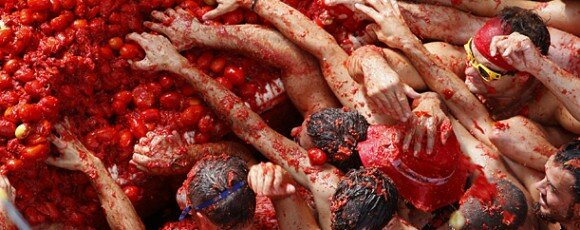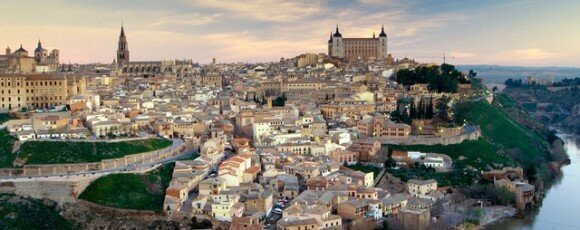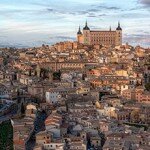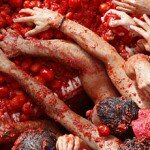En el mes de Agosto se celebra en Buñol una curiosa fiesta dónde el principal protagonista es el tomate. Para todos aquéllos que queráis saber más sobre esta tradicional fiesta valenciana, aquí os incluimos información muy útil en caso de que estéis planeando un viaje a Valencia este verano. Esta fiesta tiene su origen en el año 1945 cuando unos chicos jóvenes estaban viendo un desfile de gigantes y cabezudos durante las fiestas del pueblo. Desafortunadamente uno de los jóvenes hizo...
festival, spanish culture, summer, tomatina, valencia
How to celebrate in Madrid: The traditional opening speech in Plaza de la Villa, Saturday the 9thof February at 18.00, marks the beginning of the 2013’s Spanish Festival. This grand festival will fill the city of Madrid with a joyful mood, party and fantasy. Just as previous years the festival contains events such as: The Big Parade, where fancy dressed professionals take the streets of Madrid, the Masquerade Dance, which is a program specifically dedicated to children, and much,...
carnival, madrid, spanish culture
I have discovered in the two years I have been living in Spain that sometimes the Spanish do very weird things. My (very British) idea of a festival or celebration involves drink, music, possibly dancing and often a speech. The Spanish like to throw fireworks, build towers out of humans, get carried around in coffins and jump over babies (all things that actually happen in yearly festivals). I have also discovered that a very large number of Spanish festivals involve throwing things. I have no...
festivals in spain, spanish culture, spanish festivals
La Tomatina is a food fight festival held every year on the last Wednesday of August in Buñol, a small town close to Valencia. The festival attracts over 40,000 people and is known as the biggest food fight in the world. Over 125 tons of ripe tomatoes provided by the town hall are thrown in the streets where people, locals and tourists alike, are allowed to fight for exactly one hour on that day. What happens in Buñol on that day? The festivities begin at around 11 a.m. on the main square of...
la tomatina, spanish culture, spanish festivals, valencia
The annual Fiesta Major de Gracia just started in the streets of the picturesque Gracia district in Barcelona and will take place until August 21st. The celebration of the neighborhood consists of a week full of events, concerts, shows, parades and amazing fireworks and is the place to be in these hot days in August! Every year the district of Gracia welcomes thousands of visitors and tourists along its streets and alleyways to dance, drink and have fun until the early morning! The Festival The...
festa major de gracia, spanish culture
It is the shortest night in the northern hemisphere and one of the most celebrated ones! On the night of June 23rd the Spaniards pay tribute to the Summer solstice with the Fiesta de San Juan, a night full of mystery, magic and rituals. The celebrations vary among different cities but no matter where you enjoy the festivities, you will find the elements fire and water everywhere! History The Festival of San Juan dates back to pre-Christian times and is an ancient pagan festival. The long...
festival san juan, fiesta de san juan, night of san juan, san juan in spain, spanish culture, spanish traditions
Discover the surroundings of Madrid With so much to do in Madrid Capital, we sometimes forget the gems that surround the city, where there is also a lot to be discovered Just south of Madrid you can find Toledo, known as the city of three cultures for having been populated for many centuries by Christians, Jews and Arabs. With a history that goes as far back as the Bronze Age, each and every corner of Toledo has a story to tell. The best thing to do is getting lost in the meandering streets. A...
avila, escorial, madrid, rural madrid, spanish culture, surrounding madrid, toledo
The city of Barcelona used to be confined until the 19th century to the outer walls of what we call the Old Town or the “Barrio Gótico”. Several towns and villages were situated at a short distance from the big town but were -proudly- independent. Today in the 21st century, all these places have been gobbled up by Barcelona and relegated to the status of neighbourhood. One such area in particular still resists the notion that it is no longer independent and this area is called...
barcelona, festa major gracia, spanish culture
Yes, the crisis may have hit the world economy but it is difficult to tell from all the gifts that an average Spanish child receives these days. The main event still is the Día de los Reyes (day of the three Kings) which is celebrated on the 6th of January. In every town of Spain, you’ll find a parade of medievally dressed Kings (in Spanish called Melchor, Gaspar y Baltasar) who’ve come to town to present the children with sweets and gifts. The parade is held on the evening of...
christmas, día de los reyes, spanish culture










 Eventos 2013: Septiembre y Octubre en Madrid
Eventos 2013: Septiembre y Octubre en Madrid  A day-trip to charming Toledo
A day-trip to charming Toledo  Tapas and drinking in Barcelona (Part 2) – Cava bars in Barcelona
Tapas and drinking in Barcelona (Part 2) – Cava bars in Barcelona  Aprende más sobre la Tomatina
Aprende más sobre la Tomatina  Summertime tips for Seville
Summertime tips for Seville 
